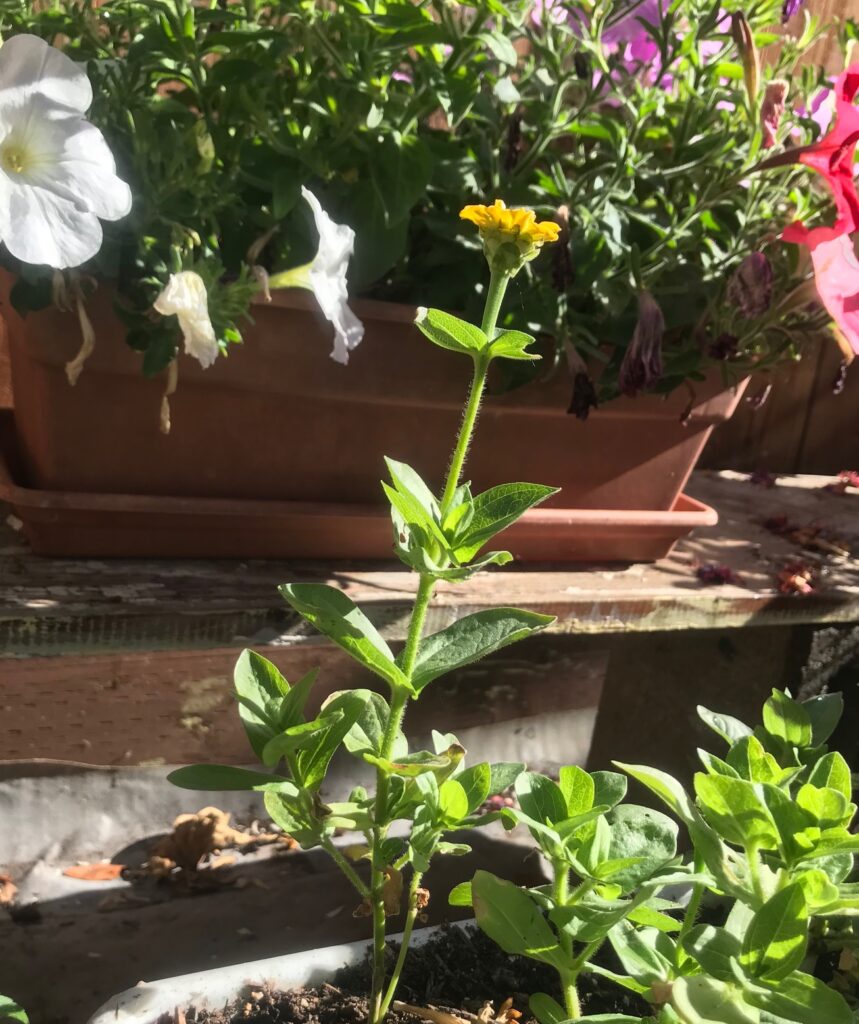Do Zinnias Do Better in Pots Or in The Ground
According to the ASPCA, zinnias are not poisonous for dogs, cats, other pets or wildlife; in fact these flowers are safe for cats and dogs. So you know, we check the flowers we feature on our site with the ASPCA and do extensive internet research for both the common and scientific name just to be super pet safe. If we cannot find direct reference, we check up to genus and so on until we can confirm whether a plant is toxic or non toxic to both cats and dogs. If we are not sure, or get contradictory information, we do not include it. Many of the plants featured we have grown successfully in our own pet safe garden in Northern California. The zinnia in the photo below is from the early days of Lovie’s Pet Safe Container Garden, proof that zinnias grow well in pots and in the ground.

Do Zinnias Like Sun or Shade & Do You Deadhead Them
Physical Attributes
- Height: 6 inches to 4 feet, depending on variety
- Flowers: Large, daisy-like blooms in various colors
- Flower size: 1 to 7 inches in diameter
- Leaves: Lance-shaped, rough-textured, opposite on stem
- Stem: Sturdy, erect, and hairy
- Bloom time: Summer to first frost
- Growth habit: Upright, bushy annual
General Care Tips
- Sunlight: Full sun (6-8 hours daily)
- Soil: Well-draining, fertile soil
- Water: Regular watering, but avoid wetting foliage
- Spacing: 6-18 inches apart, depending on variety
- Fertilizer: Light feeding every 4-6 weeks
- Deadheading: Remove spent blooms to encourage more flowers
- Planting: Sow seeds directly after last frost or start indoors
- Pest control: Watch for aphids and spider mites
Fun Facts
- Native to Mexico and named after German botanist Johann Gottfried Zinn
- Zinnias were the first flower to bloom in space (aboard Space Shuttle Challenger in 1984)
- Available in a wide range of colors except true blue
- Symbolizes thoughts of absent friends, endurance, and lasting affection
- Attracts butterflies, hummingbirds, and beneficial insects
- Some varieties are edible and can be used as garnishes
- Zinnias were once considered a symbol of poor taste in Victorian England
- The Aztecs called the flower “evil eye of the corn” due to its appearance
- Zinnias are part of the Asteraceae family, related to daisies and sunflowers
- They make excellent cut flowers with a long vase life
Do Zinnias Come Back Every Year
| Consideration | Answer |
|---|---|
| Container Friendly | Yes |
| Indoor/Outdoor | Primarily outdoor |
| Sun/Shade | Full sun (6-8 hours daily) |
| Perennial/Annual | Annual |
| Flowering | Summer to first frost |
| Drought Tolerant | Moderately, prefers regular watering |
| Pollinator Magnet | Yes, attracts bees, butterflies, and hummingbirds |
| Beginner Friendly | Yes, easy to grow |
| Good Ground Cover | No, typically upright growth |
| Good Privacy Screen | No, generally too short |
| Invasive/Spreader | No, not invasive |
| Hearty/Delicate | Hearty |
| Rodent Repellant | No specific information available |
| Deer Resistant | No, deer may eat zinnias |
| Native To | Mexico and Central America |
| Ideal States/Regions | Adaptable to most regions, best in USDA zones 3-10 |
Citations:
[1] https://sfrecpark.org/Facilities/Facility/Details/Francisco-Park-Dog-Play-Area-445
[2] https://sfstandard.com/2022/07/27/best-dog-parks-guide-san-francisco/
[3] https://sfrecpark.org/457/Dog-Play-Areas
[4] https://www.reddit.com/r/sanfrancisco/comments/10e66uf/dog_park_recommendations/
[5] https://hort.extension.wisc.edu/articles/spotted-deadnettle-lamium-maculatum/
[6] https://www.wildflower.org/plants/result.php?id_plant=COHE
[7] https://www.gardenia.net/plant/collinsia-heterophylla
[8] https://www.everwilde.com/store/Collinsia-heterophylla-WildFlower-Seed.html
[9] https://larnerseeds.com/products/collinsia-heterophylla-purple-chinese-houses
[10] https://naturecollective.org/plant-guide/details/chinese-houses/





